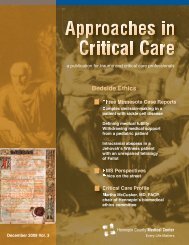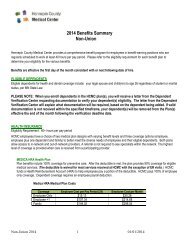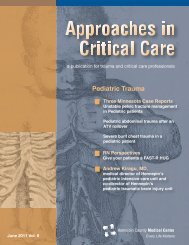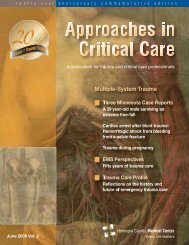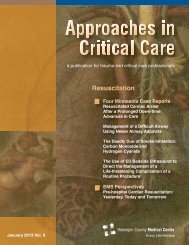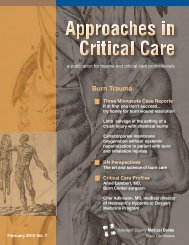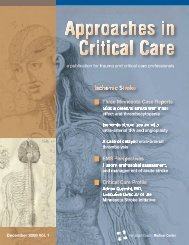Em. Med. Annual Report 2011 - Hennepin County Medical Center
Em. Med. Annual Report 2011 - Hennepin County Medical Center
Em. Med. Annual Report 2011 - Hennepin County Medical Center
You also want an ePaper? Increase the reach of your titles
YUMPU automatically turns print PDFs into web optimized ePapers that Google loves.
Hitchcock nodded his approval. No papers were<br />
signed. Ruiz became Chief of the ED. He<br />
remained on the surgical staff and helped provide<br />
surgical coverage for fifteen more years.<br />
Ruiz found that he had much to learn if he was<br />
going to be an emergency physician as well as a<br />
general surgeon. One never knew what was going<br />
to come through the door next. It was obvious that<br />
residency training in EM was needed. Two second<br />
year surgery residents, G. Patrick Lilja and Robert<br />
S. Long (1938-2005) were drawn to the ED by its<br />
variety and intensity. They had read an article in a<br />
news magazine describing the new residency in<br />
EM at Cincinnati General and called it to Ruiz's<br />
attention. Within days Ruiz put together a<br />
curriculum and sent it off to the fledgling ACEP for<br />
a reaction. No response returned, but the<br />
residency was started anyway in the fall of 1971<br />
with Lilja and Long as the first residents. Hitchcock<br />
allowed the two residents to switch to EM and<br />
even agreed to continue their stipends for the<br />
remainder of their year. The various services<br />
welcomed the additional support from EM<br />
residents. Hitchcock never told Ruiz he approved<br />
of EM, but his support for the residency showed<br />
his willingness to give it a chance.<br />
In 1972, one of Ruiz's first goals was to stop the<br />
practice of rushing critical patients "upstairs." A<br />
well equipped room in the ED should be kept<br />
ready for such patients. Prose was in complete<br />
agreement, having observed the dangers of the<br />
rush-upstairs practice as an ED nursing director.<br />
An ENT exam room could be refurbished as a<br />
"Stabilization Room." Prose successfully recruited<br />
a respected Night Supervisor who was expert in<br />
getting critical care initiated. Audrey Kuhne, RN<br />
(1929-2005) joined the ED nursing staff in 1973<br />
and helped the Stabilization Room effort obtain<br />
hospital-wide credibility<br />
and support. Ruiz and<br />
Kuhne were successful<br />
scavengers of equipment<br />
and supplies from<br />
throughout the hospital.<br />
Some equipment was of<br />
their own design and<br />
G. Patrick Lilja, MD<br />
made from scratch. The<br />
Stabilization Room<br />
contained the equipment necessary to resuscitate<br />
almost any kind of emergency patient to the point<br />
that he or she could be safely moved. Many<br />
innovations were introduced there. For example,<br />
cardiac ultrasound was first used there to<br />
diagnose cardiac tamponade on presentation to<br />
an ED. Not all cases could be "stabilized," but IVs<br />
could be started, airways opened, x-rays and labs<br />
obtained, and life-saving measures taken while an<br />
operating room or intensive care area got ready.<br />
To our knowledge, the Stabilization Room was the<br />
first of its kind in the U.S. It can be stated that it<br />
started a new age in emergency care.<br />
Lilja and Long graduated from the EM residency<br />
in 1972 and became EM staff. They almost<br />
immediately began a first-of-its-kind program of<br />
training pre-hospital personnel in emergency skills<br />
on their own initiative. This included HCMC<br />
ambulance "drivers," police, and firefighters. The<br />
ambulance drivers became <strong>Em</strong>ergency <strong>Med</strong>ical<br />
Technicians (EMT) and Paramedics according to<br />
the skill level they achieved. ED nurses lamented<br />
that Lilja and Long were not always in the ED, but<br />
when patients arrived in better condition, they<br />
appreciated their efforts.<br />
In 1973, Ruiz was in the ED when a call came<br />
from the airport reporting that an airliner was about<br />
to land without its landing gear. The runway was<br />
7:00 am




